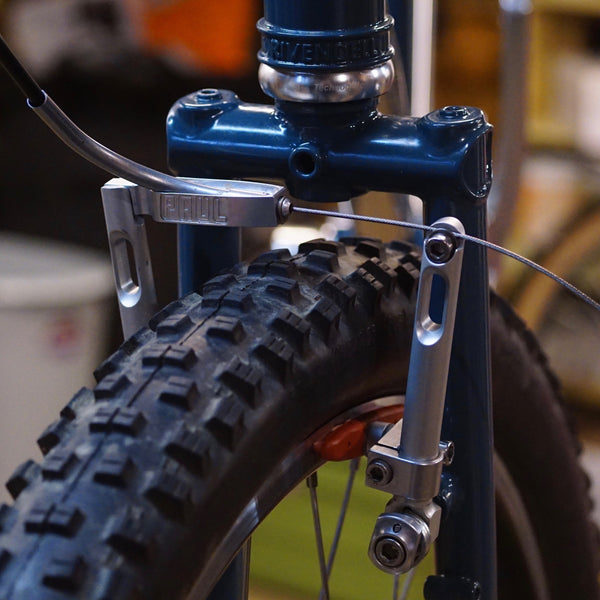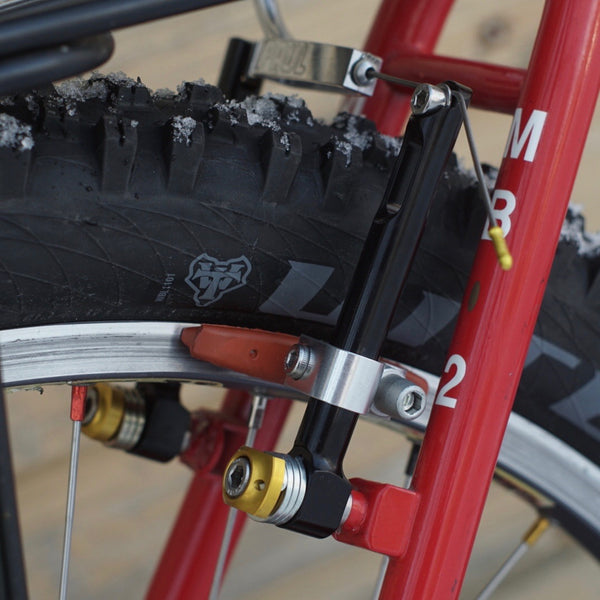Fall and Winter Analog Events: Xmas Lights ride, a Fifth Season Pop Up and a Holiday Market. Dive in here!






















With many high end bits and such, we can't possibly stock 'em all, but we appreciate you ordering thru us, regardless. If you read about here, and learned something, that's a good reason to snag it here. There's a bit of lead time, but that's the case with most high end bike bits! It would be the same if you ordered it direct, or on Jenson or whatever.
V Brakes are the same thing as linear pull brakes. V Brake is just a trade name for Shimano’s linear pull brake. Like Kleenex is to tissues. You can use either or in mixed company, and if someone corrects you on it, you should immediately unfriend them in real life.
V brakes were invented out of necessity. Frame suspension forced the creation of V Brakes. I’ve heard a few V brake origin stories, but the one I like best is about Tom Bruni. In the late 80’s Tom Bruni was building all sorts of funky bikes like triplets and special needs recumbents for folks, in addition to traditional touring bikes. He was an early adopter of suspension, even for road bikes. One of his designed called for rear suspension, but the current cantilever brakes out there could not be installed on the design, as the action of the suspension would cause the brake cable to go slack as the suspension moved through it’s travel. Bruni needed a brake. The one he came up with was the first V brake. Because, at the time, no one was really interested in rear suspension, he did not recognize the market value. After all, he was using it on a one-off bike, it was not a market need that arose in the 80’s. He failed to patent it. And a few years later, Shimano did …
Cantilevers reached a pinnacle of design in the early 90’s, which has never been surpassed or even matched. The strongest Canti on the market today is one that has not changed since the early 90’s. The mighty (and mighty cheap) Shimano Alivio canti. The Alivio is a cheap, poorly finished copy of the perfect Shimano XT Cantilever. It works exactly the same. Just ditch the brake pads, which are made of ‘rubber’ from recycled bakelite poker chips. Trade 'em for some Kool Stops and you are set.
Oh man. Isn’t this article supposed to be about Paul stuff, and those fancy brakes he makes? Right, right. Back at it then.
Paul made all sorts of crazy brake designs back in the day. Toggle cam brakes were my favorite. They were a stab at making a brake that would work as good as the best cantilever brakes, but could be used with suspension. Toggle cams were overly complex, and they quickly went the way of Reebok Pumps. Ok they actually still make Pumps, so if you want to relive my middle school years, go to a Foot Locker, convince your buddy to pump one up till it pops. Don’t actually do that. It’s vandalism.
So it’s the early 90’s and everyone is trying to do something that is more rad than Shimano. Or at least make something that could be anodized purple. Also, people were trying to get around Shimano’s patents and licensing strangle holds on brakes, derailleurs, and golf clubs. The big one to avoid on brakes was the linear spring. Shimano V brakes used a linear spring. It’s light, easy to adjust, and pretty dang brilliant really. Brake manufacturers got around this patent a variety of ways. Paul, Avid and WTB (among others) used a coiled spring rather than a linear spring. The main advantage with these springs is infinite adjustability. Sometimes when you are setting up Shimano V brakes (or Tektros, etc), you have to bend the linear spring out to get it to produce enough return power to keep the brake pads from rubadubdubing on the rim. The coil spring is also replaceable. In fact, every piece of the Paul brake (not just these brakes, but all of them) is replaceable. So if the bushings wear out (they won’t), you can replace them.
Motolites were invented before V Brake pads (& their conical washers) were prevalent. Maybe those pads were not even invented yet, someone nerdier nerd than me can write me and tell me, and I’ll amend this jeremiad.
Regardless, Paul had to figure out how to use brake pads that bolted on to the brake arms, but lacketh’d in the toe-in department. This should explain the brake pad’s mount interface being able to slide up and down, as well as its ability to rotate on the brake arm. Those would be handy features, if your brake pad was an older bolt on style brake pad, like U brakes use to rock.
I think Paul knew the brake was good, and stiff, and people liked it, so when V brake pads became standard, he left the Motolite alone. The newer Paul brakes all use ‘normal’ slotted brake pad holders, because they were designed after V brake pads became standard.
So here’s the thing with Paul Motolites. They are kinda a pain to set up. Like an old canti brake. But they make up for being ornery little munchkins in 3 ways. Ok 4. One: you can get them in weird colors. Two: if any part wears out, Paul has your back. 1994 Paul bushings can be used on 2018 Paul brakes. Ditto spring adjusters, springs, and all that sort of stuff. Shimano doesn’t support things like that. Three: They’re highly adjustable. That’s helpful on some bikes, where, for instance, the bike was designed around narrower rims and you wanna run big wide rims, but normal brakes won’t let you slam the brake pad low enough on the brake arm. Four: They’re wicked stiff. Much bigger and beefier than any currently made V brake. That translates to power, which means you can stop easier, even with a loaded bike. Ok, I lied, there is a 5th reason. They’re CNC’d. Most brakes are cast. Casting is good cause it’s cheap, and low waste and it’s fast. CNC machining is slow, high waste and expensive. But it’s way more accurate: you can machine a brake arm and it’s pivot hole to a much tighter tolerance than a cast brake arm. When you start braking, there is no play in the brake pivots, just instant braking power. The brakes are more responsive as a result, and can be set up with the brake pads further from the rim. Good for wobbly rims on well traveled touring bikes, or mud clearance on gravel bikes.
Paul Motolites have one more feature that’s kinda rad: they come with a weird, big proprietary brake noodle. It’s stiffer than a normal v brake noodle, and the top of the noodle comes with a barrel adjuster. Great for running the brakes with drop bar brake levers, which don’t have built in barrel adjusters. The noodle is semi integrated into the noodle holder thing, and the noodle holder thing has a innovative and really safe / stiff way of hooking to the brake arm. Usually, on normal V brakes, this holder is cheap stamped steel, and not only is it sorta easily bent, but it also is fairly common for newbies to reconnect their brake in a way that will lead to the noodle popping out of the noodle holder. It can look almost normal, but when you grab the brake lever, the noodle comes flying out and wham! You have no brake. Next to impossible to do that with the Paul Motolite.
One last thing. It’s made in a small factory in Chico, California by people who actually ride bikes. Very, very few bike things are made in the US any more. Many of the things still made here are made in places where the workers don’t ride, don’t care about riding, it’s just a paycheck. Paul’s little machine shop is run and owned by rad people who deserve your support. Can you get a cheaper brake that works ok? Heck yeah. But consider getting the Paul brakes, even so. We live in a world where craftspeople have long been thrown under the rug. Think about doing your part to help them keep making great stuff. That’s ostensibly the same reason you are even on this website, after all!
Our on-line store is open 24/7 and we ship Monday through Friday, excluding some holidays. Orders received for products without shipping restrictions on its product page will ship the same business day when received before 12:00 p.m. PST. Orders in high demand will have an estimated production time listed on its product page and will ship according to the date listed.
The best tools out there are beautiful, highly functional, durable and serviceable. Enlightened bikes are efficient, beautiful, comfortable and fun to work on. A bicycle brings you closer to experiences, they enrich a locality, they are spiritual partners on your journey through life. Analog Cycles builds enlightened bikes for life’s peregrinations.
© 2025, Analog Cycles Powered by Shopify
